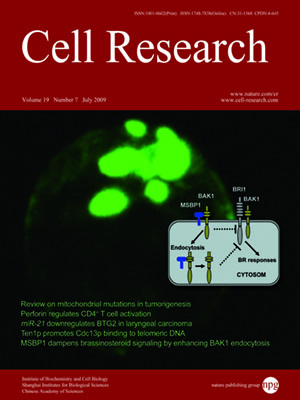
Volume 19, No 7, Jul 2009
ISSN: 1001-0602
EISSN: 1748-7838 2018
impact factor 17.848*
(Clarivate Analytics, 2019)
Volume 19 Issue 7, July 2009: 816-827
ORIGINAL ARTICLES
Novel function of perforin in negatively regulating CD4+ T cell activation by affecting calcium signaling
Enguang Bi1, Chunjian Huang1, Yu Hu1, Xiaodong Wu1, Weiwen Deng1, Guomei Lin1, Zhiduo Liu1, Lin Tian1, Shuhui Sun2, Kairui Mao1, Jia Zou1, Yuhan Zheng1 and Bing Sun1,3
1Laboratory of Molecular Cell Biology, Institute of Biochemistry and Cell Biology, Shanghai Institutes for Biological Sciences, Chinese Academy of Sciences, 320 Yueyang Road, Shanghai 200031, China
2Fudan University School of Medicine, Shanghai 200032, China
3Institute Pasteur of Shanghai, Chinese Academy of Sciences, Shanghai 200025, China
Correspondence: Bing Sun,(bsun@sibs.ac.cn)
Perforin is a pore-forming protein engaged mainly in mediating target T cell death and is employed by cytotoxic T lymphocytes (CTLs) and natural killer cells. However, whether it also plays a role in conventional CD4
+ T cell function remains unclear. Here we report that in perforin-deficient (PKO) mice, CD4
+ T cells are hyperproliferative in response to T cell receptor (TCR) stimulation. This feature of hyperproliferation is accompanied by the enhancement both in cell division and in IL-2 secretion. It seems that the perforin deficiency does not influence T cell development in thymus spleen and lymph node.
In vivo, perforin deficiency results in increased antigen-specific T cell proliferation and antibody production. Furthermore, PKO mice are more susceptible to experimental autoimmune uveitis. To address the molecular mechanism, we found that after TCR stimulation, CD4
+ T cells from PKO mice display an increased intracellular calcium flux and subsequently enhance activation of transcription factor NFAT1. Our results indicate that perforin plays a negative role in regulating CD4
+ T cell activation and immune response by affecting TCR-dependent Ca
2+ signaling.
Cell Research (2009) 19:816-827. doi: 10.1038/cr.2009.32; published online 17 March 2009
FULL TEXT | PDF
Browse 2068


